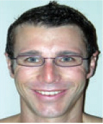Developments in Using Scanning Probe Microscopy To Study Molecules on Surfaces — From Thin Films and Single-Molecule Conductivity to Drug–Living Cell Interactions
Pall Thordarson A B D , Rob Atkin B , Wouter H. J. Kalle C , Gregory G. Warr B and Filip Braet AA Australian Key Centre for Microscopy and Microanalysis, University of Sydney, Sydney NSW 2006, Australia.
B School of Chemistry, University of Sydney, Sydney NSW 2006, Australia.
C School of Biomedical Sciences and Bioimaging Analysis Group (BIAG), Charles Sturt University, Wagga Wagga NSW 2678, Australia.
D Corresponding author. Email: p.thordarson@chem.usyd.edu.au

Pall Thordarson is an Australian Research Council Australian Research Fellow at the School of Chemistry, University of Sydney. He obtained his B.Sc. from the University of Iceland in 1996 and Ph.D. from the University of Sydney in 2001. He then received a Marie Curie post-doctoral fellowship at the University of Nijmegen (The Netherlands), where he remained for two years before obtaining a Sesqui Research Fellowship to return to the University of Sydney. His research interests include the creation of novel materials, drugs, and devices by bio-mimetic self-assembly, and the application of AFM and STM to understand and control these processes. |

Rob Atkin is an Australian Research Council Postdoctoral Fellow at the School of Chemistry, University of Sydney. He completed his B.Sc.(Hons) and Ph.D. in physical chemistry at the University of Newcastle in 2002, followed by a post doctoral position at Bristol University (UK). His research interests include the mechanism of surfactant adsorption at the solid–aqueous solution interface, microencapsulation, and surfactant aggregation in ionic liquids. |

Wouter Kalle graduated in 1988 from the State University of Utrecht (The Netherlands) and obtained his Ph.D. in 1993 from the University of Leiden (The Netherlands). He then worked as a post-doctoral fellow on AFM at the Department of Cytochemistry and Cytometry, University of Leiden. He took up his present position as lecturer at the School of Biomedical Sciences, Charles Sturt University, in 1997. His research interests are focussed on molecular mechanisms of cancer using both molecular biology and fluorescent microscopy techniques. |

Gregory Warr completed his B.Sc.(Hons) and Ph.D. at the University of Melbourne, followed by postdoctoral fellowships at the University of Minnesota and the Centre d’Etudes Nucléaires (Saclay). He is currently Professor in Physical Chemistry at the University of Sydney, and a member of the Editorial Board for the Australian Journal of Chemistry. His research interests include amphiphilic self-assembly in bulk and at interfaces, particularly the use of neutron beam techniques and atomic force microscopy. |

Filip Braet's publications cover the areas of multidimensional correlative imaging, liver biology and pathobiology, colorectal cancer, and transendothelial transport mechanisms. He obtained his Ph.D. in 1999 at the Free University of Brussels (Belgium) and currently holds the positions of Associate Professor, Biologist and Deputy Director in theAustralian Key Centre for Microscopy & Microanalysis, at the University of Sydney. To date, he has 47 publications (including three invited book chapters) directly related to the molecular dynamics of various cell types as probed by atomic force microscopy, and has presented 23 international talks about this part of his research. |
Australian Journal of Chemistry 59(6) 359-375 https://doi.org/10.1071/CH06043
Submitted: 31 January 2006 Accepted: 30 May 2006 Published: 6 July 2006
Abstract
Scanning probe microscopy (SPM) techniques, including atomic force microscopy (AFM) and scanning tunnelling microscopy (STM), have revolutionized our understanding of molecule–surface interactions. The high resolution and versatility of SPM techniques have helped elucidate the morphology of adsorbed surfactant layers, facilitated the study of electronically conductive single molecules and biomolecules connected to metal substrates, and allowed direct observation of real-time processes such as in situ DNA hybridization and drug–cell interactions. These examples illustrate the power that SPM possesses to study (bio)molecules on surfaces and will be discussed in depth in this review.
Acknowledgments
The authors thank their past and present collaborators for their contribution to this field. They also acknowledge the facilities as well as scientific and technical assistance from staff in the NANO Major National Research Facility at the Electron Microscope Unit, University of Sydney. P.T. thanks the University of Sydney for Sesqui Fellowship and the Australian Research Council for an Australian Research Fellowship and support from the Discovery and Linkage project programs. R.A. thanks the Australian Research Council for the provision of a Postdoctoral Fellowship.
[1]
G. Binnig,
H. Rohrer,
C. Gerber,
E. Weibel,
Phys. Rev. Lett. 1982, 49, 57.
| Crossref | GoogleScholarGoogle Scholar |
| Crossref | GoogleScholarGoogle Scholar |
| Crossref | GoogleScholarGoogle Scholar |
| Crossref | GoogleScholarGoogle Scholar |
| Crossref | GoogleScholarGoogle Scholar |
| Crossref | GoogleScholarGoogle Scholar |
| Crossref | GoogleScholarGoogle Scholar |
| Crossref | GoogleScholarGoogle Scholar |
| Crossref | GoogleScholarGoogle Scholar |
| Crossref | GoogleScholarGoogle Scholar |
| Crossref | GoogleScholarGoogle Scholar |
| Crossref | GoogleScholarGoogle Scholar |
| Crossref | GoogleScholarGoogle Scholar |
| Crossref | GoogleScholarGoogle Scholar |
| Crossref | GoogleScholarGoogle Scholar |
| Crossref | GoogleScholarGoogle Scholar |
| Crossref | GoogleScholarGoogle Scholar |
| Crossref | GoogleScholarGoogle Scholar |
| Crossref | GoogleScholarGoogle Scholar |
| Crossref | GoogleScholarGoogle Scholar |
| Crossref | GoogleScholarGoogle Scholar |
| Crossref | GoogleScholarGoogle Scholar |
| Crossref | GoogleScholarGoogle Scholar |
| Crossref | GoogleScholarGoogle Scholar |
| Crossref | GoogleScholarGoogle Scholar |
| Crossref | GoogleScholarGoogle Scholar |
| Crossref | GoogleScholarGoogle Scholar |
| Crossref | GoogleScholarGoogle Scholar |
| Crossref | GoogleScholarGoogle Scholar |
| Crossref | GoogleScholarGoogle Scholar |
| Crossref | GoogleScholarGoogle Scholar |
| Crossref | GoogleScholarGoogle Scholar |
| Crossref | GoogleScholarGoogle Scholar |
| Crossref | GoogleScholarGoogle Scholar |
| Crossref | GoogleScholarGoogle Scholar |
| Crossref | GoogleScholarGoogle Scholar |
| Crossref | GoogleScholarGoogle Scholar |
| Crossref | GoogleScholarGoogle Scholar |
| Crossref | GoogleScholarGoogle Scholar |
| Crossref | GoogleScholarGoogle Scholar |
| Crossref | GoogleScholarGoogle Scholar |
| Crossref | GoogleScholarGoogle Scholar |
| Crossref | GoogleScholarGoogle Scholar |
| Crossref | GoogleScholarGoogle Scholar |
| Crossref | GoogleScholarGoogle Scholar |
| Crossref | GoogleScholarGoogle Scholar |
| Crossref | GoogleScholarGoogle Scholar |
| Crossref | GoogleScholarGoogle Scholar |
| Crossref | GoogleScholarGoogle Scholar |
| Crossref | GoogleScholarGoogle Scholar |
| Crossref | GoogleScholarGoogle Scholar |
| Crossref | GoogleScholarGoogle Scholar |
| Crossref | GoogleScholarGoogle Scholar |
| Crossref | GoogleScholarGoogle Scholar |
| Crossref | GoogleScholarGoogle Scholar |
| Crossref | GoogleScholarGoogle Scholar |
| Crossref | GoogleScholarGoogle Scholar |
| Crossref | GoogleScholarGoogle Scholar |
| Crossref | GoogleScholarGoogle Scholar |
| Crossref | GoogleScholarGoogle Scholar |
| Crossref | GoogleScholarGoogle Scholar |
| Crossref | GoogleScholarGoogle Scholar |
| Crossref | GoogleScholarGoogle Scholar |
| Crossref | GoogleScholarGoogle Scholar |
| Crossref | GoogleScholarGoogle Scholar |
| Crossref | GoogleScholarGoogle Scholar |
| Crossref | GoogleScholarGoogle Scholar |
| Crossref | GoogleScholarGoogle Scholar |
| Crossref | GoogleScholarGoogle Scholar |
| Crossref | GoogleScholarGoogle Scholar |
| Crossref | GoogleScholarGoogle Scholar |
| Crossref | GoogleScholarGoogle Scholar |
| Crossref | GoogleScholarGoogle Scholar |
| Crossref | GoogleScholarGoogle Scholar |
| Crossref | GoogleScholarGoogle Scholar |
| Crossref | GoogleScholarGoogle Scholar |
| Crossref | GoogleScholarGoogle Scholar |
| Crossref | GoogleScholarGoogle Scholar |
| Crossref | GoogleScholarGoogle Scholar |
| Crossref | GoogleScholarGoogle Scholar |
| Crossref | GoogleScholarGoogle Scholar |
| Crossref | GoogleScholarGoogle Scholar |
| Crossref | GoogleScholarGoogle Scholar |
| Crossref | GoogleScholarGoogle Scholar |
| Crossref | GoogleScholarGoogle Scholar |
| Crossref | GoogleScholarGoogle Scholar |
| Crossref | GoogleScholarGoogle Scholar |
| Crossref | GoogleScholarGoogle Scholar |
| Crossref | GoogleScholarGoogle Scholar |
| Crossref | GoogleScholarGoogle Scholar |
| Crossref | GoogleScholarGoogle Scholar |
| Crossref | GoogleScholarGoogle Scholar |
| Crossref | GoogleScholarGoogle Scholar |
| Crossref | GoogleScholarGoogle Scholar |
| Crossref | GoogleScholarGoogle Scholar |
| Crossref | GoogleScholarGoogle Scholar |
| Crossref | GoogleScholarGoogle Scholar |
| Crossref | GoogleScholarGoogle Scholar |
| Crossref | GoogleScholarGoogle Scholar |
| Crossref | GoogleScholarGoogle Scholar |
| Crossref | GoogleScholarGoogle Scholar |
| Crossref | GoogleScholarGoogle Scholar |
| Crossref | GoogleScholarGoogle Scholar |
| Crossref | GoogleScholarGoogle Scholar |
| Crossref | GoogleScholarGoogle Scholar |
| Crossref | GoogleScholarGoogle Scholar |
| Crossref | GoogleScholarGoogle Scholar |
| Crossref | GoogleScholarGoogle Scholar |
| Crossref | GoogleScholarGoogle Scholar |
| Crossref | GoogleScholarGoogle Scholar |
| Crossref | GoogleScholarGoogle Scholar |
| Crossref | GoogleScholarGoogle Scholar |
| Crossref | GoogleScholarGoogle Scholar |
| Crossref | GoogleScholarGoogle Scholar |
| Crossref | GoogleScholarGoogle Scholar |
| Crossref | GoogleScholarGoogle Scholar |
| Crossref | GoogleScholarGoogle Scholar |
| Crossref | GoogleScholarGoogle Scholar |
| Crossref | GoogleScholarGoogle Scholar |
| Crossref | GoogleScholarGoogle Scholar |
| Crossref | GoogleScholarGoogle Scholar |
| Crossref | GoogleScholarGoogle Scholar |
| Crossref | GoogleScholarGoogle Scholar |
| Crossref | GoogleScholarGoogle Scholar |
| Crossref | GoogleScholarGoogle Scholar |
| Crossref | GoogleScholarGoogle Scholar |
| Crossref | GoogleScholarGoogle Scholar |
| Crossref | GoogleScholarGoogle Scholar |
| Crossref | GoogleScholarGoogle Scholar |
| Crossref | GoogleScholarGoogle Scholar |
| Crossref | GoogleScholarGoogle Scholar |
| Crossref | GoogleScholarGoogle Scholar |
| Crossref | GoogleScholarGoogle Scholar |
| Crossref | GoogleScholarGoogle Scholar |
| Crossref | GoogleScholarGoogle Scholar |
| Crossref | GoogleScholarGoogle Scholar |
| Crossref | GoogleScholarGoogle Scholar |



